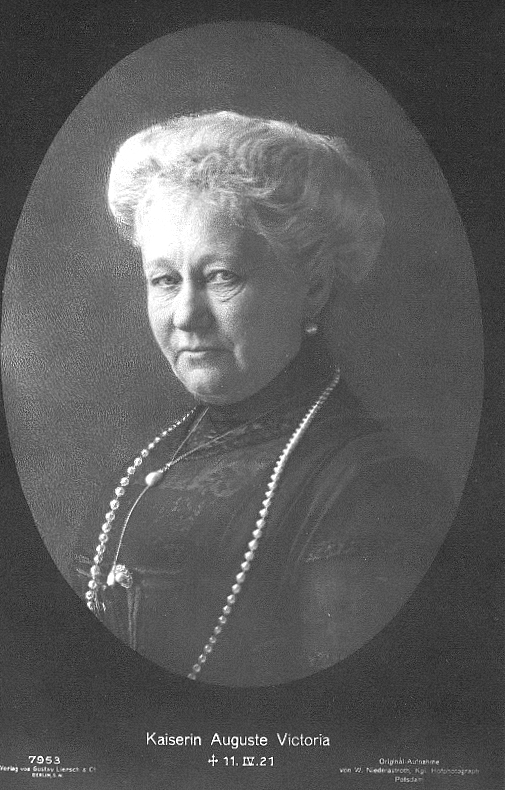© Unofficial Royalty 2025

Augusta Viktoria of Schleswig-Holstein-Sonderburg-Augustenburg, German Empress; Credit – Wikipedia
April 11, 1240 – Death of Llywelyn Fawr (the Great), Prince of Gwynedd, Prince of Southern Powys at the Abbey of Aberconwy in Wales, buried at the Abbey of Aberconwy
Llywelyn was the topic of the late Sharon Kay Penman’s excellent historical novel “Here Be Dragons.” Llywelyn ap Iorwerth (“ap” means “son of”), later known as Llywelyn Fawr (Llywelyn the Great) was the longest-reigning ruler of Welsh principalities, maintaining control for 45 years. He was Prince of Gwynedd and Prince of Powys Wenwynwyn. In 1216, Llewellyn received the fealty of other Welsh lords and, although he never used the title, was the de facto Prince of Wales. Llywelyn dominated Wales for 45 years and was one of only two Welsh rulers called “the Great”, the other being his ancestor Rhodri the Great.
Unofficial Royalty: Llywelyn Fawr, Prince of Gwynedd, Prince of Southern Powys
April 11, 1611 – Birth of Karl Eusebius, Prince of Liechtenstein
In 1627, when Karl Eusebius was fifteen years old, his father Karl I, the first Prince of Liechtenstein, died, and he became the second Prince of Liechtenstein. In 1644, Karl Eusebius married his niece Johanna Beatrix of Dietrichstein, and they had nine children. Karl Eusebius I successfully consolidated and rebuilt the House of Liechtenstein territories devastated by the Thirty Years’ War. He left his son and successor, Hans-Adam I, Prince of Liechtenstein, a rich inheritance and an extensive collection of artworks that were multiplied by his son and other descendants. The current Prince of Liechtenstein, Hans-Adam II, is the richest European monarch. After a reign of 57 years, Karl Eusebius died at the age of 72, on April 5, 1684.
Unofficial Royalty: Karl Eusebius, Prince of Liechtenstein
April 11, 1624 – Birth of Maria Ilyinichna Miloslavskaya, Tsaritsa of All Russia, first wife of Alexei I, Tsar of All Russia, in Moscow, Russia
In 1648, Maria Ilyinichna married Alexei I, Tsar of All Russia. They had thirteen children, including two Tsars of All Russia, Fyodor III and Ivan V, and Sophia Alexeevna, who served as Regent for her brother Ivan V and half-brother Peter I (the Great). During this time, the life of Russian noblewomen, including the Tsaritsa of All Russia, was not a public one. They were expected to live in seclusion with little contact with men. Maria Ilyinichna was mainly involved in charitable and religious activities such as donating to facilities for the poor, sick, and disabled. On March 13, 1669, 45-year-old Maria Ilyinichna died of puerperal fever (childbed fever) five days after her most difficult childbirth. Her thirteenth child, Yevdokia Alexeevna, lived for only two days.
Unofficial Royalty: Maria Ilyinichna Miloslavskaya, Tsaritsa of All Russia
April 11, 1921 – Death of Augusta Viktoria of Schleswig-Holstein-Sonderburg-Augustenburg (called Dona), German Empress, first wife of Wilhelm II, German Emperor, at Huis Doorn in the Netherlands; buried in the Antique Temple in the garden of Sanssouci Palace in Potsdam, Germany
Known as Dona, she was a great-niece of Queen Victoria, a niece of Prince Christian of Schleswig-Holstein, the husband of Queen Victoria’s daughter Princess Helena, and a descendant of Danish and British kings. In 1881, Dona married the future Wilhelm II, German Emperor and King of Prussia. They had six sons and one daughter. When Dona became German Empress and Queen of Prussia in 1888, she took up and enjoyed the traditional roles of a consort, serving as a hostess and working with charities. Dona’s health had started to fail even before Wilhelm lost his throne in the aftermath of World War I, which necessitated their going into exile in the Netherlands. In 1920, Dona and Wilhelm’s youngest son Joachim died by suicide. Dona never got over her son’s death, and she died five months later. Dona had wanted to be buried in Germany, but this meant that Wilhelm would never be able to visit her grave as he was exiled. The German government agreed to the burial but insisted that the special train that carried Dona’s coffin only travel at night and that there should be no announcement of the arrangements. Dona was still popular with the German people, and even though there were no announcements about the arrangements, the 600-kilometer route through Germany was lined with people.
Unofficial Royalty: Augusta Viktoria of Schleswig-Holstein-Sonderburg-Augustenburg, German Empress, Queen of Prussia
This article is the intellectual property of Unofficial Royalty and is NOT TO BE COPIED, EDITED, OR POSTED IN ANY FORM ON ANOTHER WEBSITE under any circumstances. It is permissible to use a link that directs to Unofficial Royalty.
